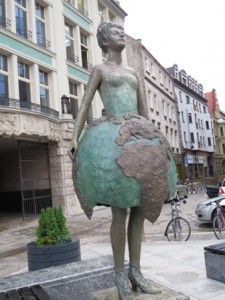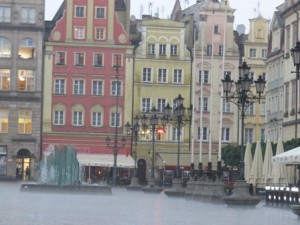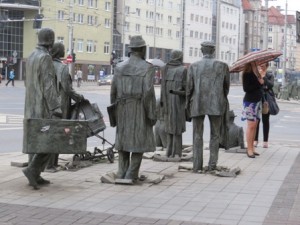 of history, culture and people city which in 2016 will be culture capital of Europe presents visitors with multitude of exiting impressions. This Piast , earliest Polish Kings dynasty , town represents very rich mosaic of Polish and European history . Name Wroclaw , being on the cross roads of Amber Route and commercial roads , tracks between Eastern and western parts of Europe on the northern part of the Carpathian Mountains , as historical annals say comes from Bohemian Duke Vratislav I. This town is example of powerful Piast Dynasty . The year of 990 when Duke Mieszko I of Poland conquered Silesia and Wroclaw was the start of importance . In Wroclaw soon after Mieszko I accepted Christianity , his son King Boleslaw I / Great / established here bishopric of Wroclaw . This amazing town is the symbol of Polish presence in this remarkable corner of Poland and dynamic region of Europe. Wroclaw like the Silesia was ruled in these early years of 2nd millennium by Silesian Piast dynasty . Dynasty which was the foundation of Polish Kingdom . As an evidence of strong influences of Poland presence in Wroclaw through centuries one needs to bear in mind fact that in 1475, the first Polish language book ,
of history, culture and people city which in 2016 will be culture capital of Europe presents visitors with multitude of exiting impressions. This Piast , earliest Polish Kings dynasty , town represents very rich mosaic of Polish and European history . Name Wroclaw , being on the cross roads of Amber Route and commercial roads , tracks between Eastern and western parts of Europe on the northern part of the Carpathian Mountains , as historical annals say comes from Bohemian Duke Vratislav I. This town is example of powerful Piast Dynasty . The year of 990 when Duke Mieszko I of Poland conquered Silesia and Wroclaw was the start of importance . In Wroclaw soon after Mieszko I accepted Christianity , his son King Boleslaw I / Great / established here bishopric of Wroclaw . This amazing town is the symbol of Polish presence in this remarkable corner of Poland and dynamic region of Europe. Wroclaw like the Silesia was ruled in these early years of 2nd millennium by Silesian Piast dynasty . Dynasty which was the foundation of Polish Kingdom . As an evidence of strong influences of Poland presence in Wroclaw through centuries one needs to bear in mind fact that in 1475, the first Polish language book ,  printed and issued in Poland was in no other place but exactly in Wroclaw. This great city and surrounding area through its history reaches the very early days of European people movement . More than 3800 years ago, male, one can call traveller in these days most likely from Skåne area of today’s Sweden has made a journey all the way to the region of today’s Wroclaw . Yes , he walked all the way to this great area where Wroclaw is situated . Beside this brave fellow some other very special characters got to Wroclaw too . They always accompany the Wroclaw visitors during their tours of Wroclaw . The walking tour of splendid Wroclaw which will bring lots of great surprises . From time to time in most unbelievable places on Wroclaw streets , lanes ,squares basically all over small , smart looking , very cute gnomes appear on front of the visitors eyes . They provide special mood and spirit of adventure and discovery of Wroclaw with degree of charming fairytale flavour . Wroclaw being capital of Lower Silesia (Dolny Slask) is attractively placed on numerous islands , joined by chain of more than 100 bridges across Odra river. On the river ,between these islands small vessels provide attractive options of reaching many special places in Wroclaw and opportunity to view the town from different angle . From the boat one can see Ostrów Tumski -“Cathedral Island” with the steep towers of the St. John the Baptist Cathedral . Also “ Piasek “ , Mlynska “ , “Slodowa” Islands are in area of boat trips to present the ideas to the visitors on the history and development of the town . “ Piasek “ – sand so important in building the town , Mlyn” water mill, “ Slod”- ingredient to brew the beer are names of some of these islands where true commercial activities took place . Central point of Main Market Square provides truly colourful tapestry of interesting architectural styles . Gothic, Baroque and Art Nouveau buildings house great restaurants , shops with souvenirs , museums , wine bars for tourists joy . Here on the cobble stones of the “ Rynek “ – Market Square one senses the riches of the German, Bohemian , Austrian and Polish history and culture . On the Square very attractively one can come across memorial of Aleksander Fredro famous Polish author and poet .On the Square many other surprises await .Here at “ Piwnica Swidnicka “ situated in the Town Hall building and claimed to be Europe oldest Restaurant , dating back to 1273 which provided culinary specialities to Frederyk Chopin, Julius Slovak and Johann Goethe, contemporary Polish cuisine specialities await . The multi cultural and multi denomination history of Wroclaw is clearly visible in many corners of town . Especially in the area of “Quarter of Four Denominations ” one feels the spirit of “ melting pot “ mood of this town . Here through hundred years of the Wroclaw history many people of central Europe conducted their businesses , interacted with each other in spirit of respect of variety of world views , cultures and religions citizens of the town represented. Beside the Market Square , Plac Solny “ Salt Market “ is placed . This square placed as the auxiliary square in trading and business during old days presents attractive style of buildings . Salt, such a important commodity and merchandise , nearly like the legal tender gave the name for the square and also was place where later the Stock Exchange was placed . The Old Stock Exchange building charmingly stimulates visitors minds about the riches and money which were once upon the time traded on the floors of this lovely edifice . In Wroclaw The Laboratory Theatre , Jerzy Grotowski experimental , world renown theatre presented to the world new concepts of theatrical expression . Wroclaw Opera and ballet theatre are of world class . Museums , Galleries await the guests to this truly attractive town . In Wroclaw mighty , cycloramic painting of “ Panorama Raclawicka “ illustrating the Battle of Raclawice, during the Kosciuszko Uprising mesmerizes viewers with its size , colours, dynamics and historical theme where Hero of Poland and USA Tadeusz Kosciuszko , leads troops into the battle against Russian Tsarist forces . Wroclaw with its exceptional quality as the town , cultural centre is a true must to visit . Beautiful railway station of Wroclaw can be reached by comfortable train services from all major towns in Poland and neighbouring Germany and Czech Republic. LOT Polish Airlines provides with its partners like Singapore Airlines air services to Wroclaw from Warsaw and other world destinations . VISIT WROCLAW – should be in travel plans for all who desire to experience top value destination .
printed and issued in Poland was in no other place but exactly in Wroclaw. This great city and surrounding area through its history reaches the very early days of European people movement . More than 3800 years ago, male, one can call traveller in these days most likely from Skåne area of today’s Sweden has made a journey all the way to the region of today’s Wroclaw . Yes , he walked all the way to this great area where Wroclaw is situated . Beside this brave fellow some other very special characters got to Wroclaw too . They always accompany the Wroclaw visitors during their tours of Wroclaw . The walking tour of splendid Wroclaw which will bring lots of great surprises . From time to time in most unbelievable places on Wroclaw streets , lanes ,squares basically all over small , smart looking , very cute gnomes appear on front of the visitors eyes . They provide special mood and spirit of adventure and discovery of Wroclaw with degree of charming fairytale flavour . Wroclaw being capital of Lower Silesia (Dolny Slask) is attractively placed on numerous islands , joined by chain of more than 100 bridges across Odra river. On the river ,between these islands small vessels provide attractive options of reaching many special places in Wroclaw and opportunity to view the town from different angle . From the boat one can see Ostrów Tumski -“Cathedral Island” with the steep towers of the St. John the Baptist Cathedral . Also “ Piasek “ , Mlynska “ , “Slodowa” Islands are in area of boat trips to present the ideas to the visitors on the history and development of the town . “ Piasek “ – sand so important in building the town , Mlyn” water mill, “ Slod”- ingredient to brew the beer are names of some of these islands where true commercial activities took place . Central point of Main Market Square provides truly colourful tapestry of interesting architectural styles . Gothic, Baroque and Art Nouveau buildings house great restaurants , shops with souvenirs , museums , wine bars for tourists joy . Here on the cobble stones of the “ Rynek “ – Market Square one senses the riches of the German, Bohemian , Austrian and Polish history and culture . On the Square very attractively one can come across memorial of Aleksander Fredro famous Polish author and poet .On the Square many other surprises await .Here at “ Piwnica Swidnicka “ situated in the Town Hall building and claimed to be Europe oldest Restaurant , dating back to 1273 which provided culinary specialities to Frederyk Chopin, Julius Slovak and Johann Goethe, contemporary Polish cuisine specialities await . The multi cultural and multi denomination history of Wroclaw is clearly visible in many corners of town . Especially in the area of “Quarter of Four Denominations ” one feels the spirit of “ melting pot “ mood of this town . Here through hundred years of the Wroclaw history many people of central Europe conducted their businesses , interacted with each other in spirit of respect of variety of world views , cultures and religions citizens of the town represented. Beside the Market Square , Plac Solny “ Salt Market “ is placed . This square placed as the auxiliary square in trading and business during old days presents attractive style of buildings . Salt, such a important commodity and merchandise , nearly like the legal tender gave the name for the square and also was place where later the Stock Exchange was placed . The Old Stock Exchange building charmingly stimulates visitors minds about the riches and money which were once upon the time traded on the floors of this lovely edifice . In Wroclaw The Laboratory Theatre , Jerzy Grotowski experimental , world renown theatre presented to the world new concepts of theatrical expression . Wroclaw Opera and ballet theatre are of world class . Museums , Galleries await the guests to this truly attractive town . In Wroclaw mighty , cycloramic painting of “ Panorama Raclawicka “ illustrating the Battle of Raclawice, during the Kosciuszko Uprising mesmerizes viewers with its size , colours, dynamics and historical theme where Hero of Poland and USA Tadeusz Kosciuszko , leads troops into the battle against Russian Tsarist forces . Wroclaw with its exceptional quality as the town , cultural centre is a true must to visit . Beautiful railway station of Wroclaw can be reached by comfortable train services from all major towns in Poland and neighbouring Germany and Czech Republic. LOT Polish Airlines provides with its partners like Singapore Airlines air services to Wroclaw from Warsaw and other world destinations . VISIT WROCLAW – should be in travel plans for all who desire to experience top value destination . 
WMIG June 2014 More information on Wroclaw:
- http://www.poland.travel/en-us/news/wroclaw-european-capital-of-culture-2016
- http://www.wroclaw.pl/en
- http://www.mazurkas.com.pl/incoming-bureau/ for tours in Poland
 Mitch Godziemba Swiat
Mitch Godziemba Swiat mitchgodziemba
mitchgodziemba